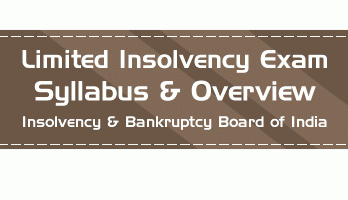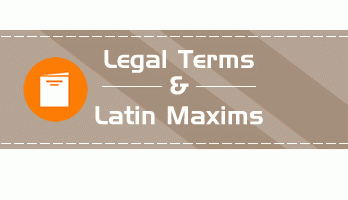This is a full-length model question paper (II from 2017) for the Limited Insolvency Exam conducted by the Insolvency and Bankruptcy Board of India ( IBBI ).
This is based on the H2 2017 syllabus which has been superseded. However, the paper is still relevant and is valuable for exam preparation and practice. The 1st model paper based on H1 2017 syllabus is at this link.
Refer to this article for the 2018 syllabus and the model paper based on the 2018 syllabus is available here.
The syllabus for this exam is revised every six months, to include the latest Judicial decisions and also the recent updates in the Insolvency Laws. Refer to the IBBI website for the syllabus for the latest exam.
1 When can a bank initiate a corporate insolvency resolution process in relation to a corporate debtor?
a) On determination of default by National Company Law Tribunal.
b) Occurrence of default.
c) On net-worth of the debtor becoming negative.
d) On the bank classified the account as Non-Performing Asset.
Ans. (b)
2 The Adjudicating Authority shall appoint an Interim Resolution Professional within days of the insolvency commencement date.
a) 07
b) 14
c) 21
d) 28
Ans. (b)
3 Can an interim resolution professional act as the resolution professional?
a) No, as it involves conflict of interest.
b) Yes, if appointed by the committee of creditors with not less than 75% of the voting share of the creditors.
c) Yes, if appointed by the committee of creditors with votes of not less than 75% of the creditors.
d) Yes, if appointed at a meeting of the committee of creditors with a majority of the creditors present and voting.
Ans. ( b)
4 Which one of the following is a pre-requisite for preparation of a resolution plan?
a) Formation of Committee of Creditors.
b) Valuation of liquidation estate by at least three registered valuers.
c) Vetting of default from at least one information utility.
d) Receipt of resolution plan(s) from financial creditors of the corporate debtor.
Ans. (a)
5 Who cannot initiate a fast track corporate insolvency resolution process?
a) financial creditor
b) operational creditor
c) corporate debtor
d) insolvency professional
Ans. (d)
6 Under which of the following circumstances, liquidation may not commence under the Insolvency and Bankruptcy Code, 2016?
a. Non-receipt of a resolution plan during the insolvency resolution period.
b. The resolution plan approved by the adjudicating authority is contravened by a financial creditor.
c. The resolution plan approved by the adjudicating authority is contravened by the corporate debtor.
d. The committee of creditors decides to liquidate the corporate debtor before confirmation of a resolution plan.
Ans. (b)
7 An application against the decision of the liquidator rejecting the claim of a creditor may be made to –
a. the Insolvency and Bankruptcy Board of India.
b. the National Company Law Tribunal.
c. the committee of creditors.
d. the Debt Recovery Tribunal.
Ans. (b)
8 The corporate debtor shall not be deemed to have given a preference if –
a. the transfer of property is for the benefit of a surety.
b. the transfer of property is on account of an antecedent financial debt.
c. the transfer creates a security interest in a property to the extent that such security interest secures new value.
d. the transfer has the effect of putting the transferee in a position better than what would have been in the event of distribution of assets under section 53.
Ans. (c)
9 Debts owed to a secured creditor in the event such secured creditor has relinquished security ranks equally with –
a) Insolvency resolution process costs.
b) Workmen’s dues for a period of 24 months prior to liquidation commencement date
c) Wages and any unpaid dues owed to employees other than workmen for the period of twelve months preceding the liquidation commencement date
d) Dues to Central Government.
Ans. (b)
10 Which of the following is not a requirement of voluntary liquidation of a company under the Insolvency and Bankruptcy Code, 2016?
a) Declaration of solvency by the members of the company.
b) Declaration from majority of Directors of the company to the effect that the company has no debt or it will be able to pay its debts in full.
c) The company has not committed any default.
d) Declaration from majority of Directors of the company to the effect that the company is not being liquidated to defraud any person.
Ans. (a)
11 A debtor may make an application for a fresh start for discharge of
a) all debts.
b) bankruptcy debts.
c) qualifying debts.
d) operational debts.
Ans. (c)
12 A debtor is eligible to apply for insolvency resolution process if he
a) is undergoing a fresh start process.
b) is undergoing a bankruptcy process.
c) is an undischarged bankrupt.
d) has not faced a previous insolvency resolution process during the period of twelve months preceding the date of submission of the application.
Ans. (d)
13 Repayment plan has to be approved by
a) a majority of creditors.
b) 3/4th in value of the creditors present in person or by proxy.
c) 3/4th in value of the creditors.
d) 3/4th of the creditors present in person or by proxy.
Ans. (b)
14 An application for bankruptcy by the debtor can be withdrawn with the leave of the
a) Insolvency and Bankruptcy Board of India.
b) Adjudicating Authority.
c) National Company Law Appellate Tribunal.
d) Committee of Creditors.
Ans. (b)
15 Who shall prepare the list of creditors after the passing of the bankruptcy order?
a) Bankruptcy trustee
b) Adjudicating Authority
c) Insolvency Professional Entity
d) Information Utility Ans. (a)
16 The estate of the bankrupt shall vest in the bankruptcy trustee from the date of
a) acceptance of the bankruptcy application.
b) passing of the bankruptcy order.
c) appointment of bankruptcy trustee.
d) issuance of public notice.
Ans. (c)
17 A committee of creditors comprises of
a) financial and operational creditors.
b) secured creditors only.
c) all financial creditors.
d) independent financial creditors only.
Ans. (d)
18 Under the code of conduct, an insolvency professional is not obliged to
a) take reasonable care and diligence while performing his duties.
b) comply with all requirements and terms and conditions of his admission to the insolvency professional entity.
c) comply with all requirements and terms and conditions of his admission to the insolvency professional agency.
d) submit a copy of the records of every proceeding before the Adjudicating Authority to the Insolvency and bankruptcy Board of India.
Ans. (b)
19 An Information Utility is not obliged to
a) create and store financial information.
b) accept electronic submissions of financial information.
c) publish statistical information.
d) register entities who can access its database.
Ans. (d)
20 The Insolvency and Bankruptcy Board of India may order any person to act as investigating authority to conduct an investigation of ….
a) Committee of Creditors.
b) Resolution Applicant.
c) Insolvency Professional Agency.
d) Insolvency Professional Entity.
Ans. (c)
21 Any person aggrieved by the order of the National Company Law Tribunal may make an appeal to
a) Debt Recovery Tribunal.
b) High Court.
c) Supreme Court.
d) National Company Law Appellate Tribunal.
Ans. (d)
22 What is the minimum punishment that may be imposed on a director of the corporate debtor who has undertaken a transaction after the insolvency commencement date to defraud the creditors?
a) Imprisonment for three years or fine of Rs.1 lakh or both.
b) Imprisonment for one year or fine of Rs.1 lakh or both.
c) Imprisonment for three years or fine of Rs.5 lakh or both.
d) Imprisonment for three years or fine of Rs.1 lakh.
Ans. (b)
23 The term of the office of Chairperson of the Insolvency and Bankruptcy Board of India is
a) 5 years or till he attains the age of 65 years, whichever is earlier.
b) 5 years or till he attains the age of 60 years, whichever is earlier.
c) 5 years
d) 3 years Ans. (a)
24 Who makes model bye-laws to be adopted by Insolvency Professional Agencies?
a) Insolvency and Bankruptcy Board of India
b) National Company Law Tribunal
c) Ministry of Corporate Affairs
d) Governing Board of the Insolvency Professional Agency
Ans. (a)
25 A debtor / creditor who provides false information in insolvency resolution process of an individual invites a maximum punishment of
a) imprisonment for one year or fine of Rs.5 lakh or both.
b) imprisonment for three years or fine of Rs.1 lakh or both.
c) imprisonment for one year or fine of Rs.1 lakh or both.
d) imprisonment for three years or fine of Rs.1 lakh.
Ans. (a)






